Everyone knows Rocky – the movie character. Not many people know Chuck Wepner – the real-life boxer who went 15 rounds with Ali – and knocked him down, too.
Wepner became the inspiration for the movie character.
Similarly, almost everyone knows the Subaru WRX STi – the all-wheel-drive Rally Race drifter. Fewer are hip to the Ford Focus RS – which was inspired by the STi and designed for similar work.
And arguably does it better.
A stronger, much quicker and all-wheel-drive-equipped enhancement of the Focus ST – just as the Soobie STi is a steroid-jacked version of the already bulgy Soobie WRX.
Almost 100 more hp.
4.7 seconds to 60.
Drift mode. Torque vectoring AWD. Recaro cinch-you-tight race seats.
Manual transmission only.
Base price is $36,995 – vs. $36,015 for its primary rival, the Subaru WRX STi.
You might also cross-shop the VW Golf R (reviewed here) for a similarly performing hot hatch in a plain brown wrapper . . . more or less.
WHAT’S NEW
The 2017 RS receives no major changes for 2017.
WHAT’S GOOD
Stronger – and quicker – than WRX STi.
Not as as notorious as the STi.
An all-out track day car that you can still drive to work without – cue Captain Freedom – pain and suffering.
WHAT’S NOT SO GOOD
 Starting price is almost a grand higher than Subaru WRX STi.
Starting price is almost a grand higher than Subaru WRX STi.
VW Golf R is quicker – and still manages to be a more agreeable everyday driver.
If you’re under 40 or have a couple of tickets to your credit the cost to insure one of these AWD buzzsaws can be as brutal as their performance.
Small gas tank (12.8 gallons) out back runs dry fast with big-power engine up front.
How much power can they pull out of 2.3 liters?
In this case, 350 hp – almost 100 hp more than the same 2.3 liter engine in the Focus ST (258 hp) and 30 more horsepower than in the Mustang, which also uses the same (more or less) 2.3 liter turbo four.
So, what accounts for the huge upswell of . . . Darth Vader voice . . . power?
More boost, for one.
And, overboost.
In the ST, the turbo maxes out around 18 psi; in the RS, it goes up to 23-plus. Briefly, when your foot goes down hard . . . if fuel quality permits and other parameters, such as altitude and air pressure are optimal.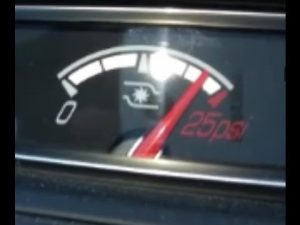
This is overboost – and it plus more aggressive cams, a factory-installed cone-type open element air cleaner and exhaust plumbing that looks like it could handle the spent gasses of a 7 liter V8 – account for the additional almost 100 hp more vs. the Focus ST.
The power peaks differently, too.
In the RS, maximum horsepower is developed at 6,000 RPM and peak torque (also 350, but ft.-lbs.) comes online at 3,200 RPM – as opposed to the ST’s 5,500 RPM horsepower peak and 2,500 RPM torque peak.
The other huge difference is how the power gets put down. The ST is front wheel drive-only while the RS is all-wheel-drive-mandatory. This isn’t just to enhance the drift-friendliness of the RS. Putting 350 hp through the front wheels only would cause horrendous torque steer problems and – probably – horrendous warranty problems, too.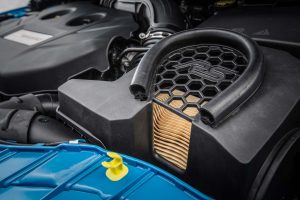
Remember: In a FWD car, the front wheels have to do two jobs – put the power down and steer the car. It’s hard to steer accurately with the wheels that steer hopping around as they try to cope with putting down the power. That’s why most really powerful FWD cars become AWD cars once the power gets beyond a certain point.
Another difference is the RS’s additional driver-selectable mode – Drift Mode – which the ST doesn’t have. There are also Sport and Track modes, as well as the default Normal mode. Each allows more – or less traction/stability control intervention and sharper – or more muted – throttle response, as well as firmer or less-firm shock settings.
Both of these hotted-up econo-cars come only with six speed manual transmissions. It helps keep the Guidos away.
Ford says the RS can nail 60 MPH in 4.7 seconds – which is nearly two seconds quicker than the Focus ST and also quicker than the Subaru WRX STi, which gets there in about 5 seconds flat. But the VW Golf R is quicker still – getting to 60 in about 4.4 seconds, which is nearly as quick as a V8-engined Mustang GT.
No huge surprise, the RS’s gas mileage is V8-esque: 19 city, 25 highway. The physical displacement of the 2.3 liter engine may be small, but when the turbo spools up, the effective displacement is twice that – as measured by how much air is moving through the thing.
So why not just go with the V8?
Several reasons, but chiefly weight distribution and, of course, packaging. A V8 in the Focus would be epic shits and giggles in a straight line but the probably 65-35 nose heavy weight split would result in an epically scary cornering experience. And regardless, fitting a V8 in a Focus would be like trying to get Amy Schumer into Brie Olsen’s bikini.
The good old days weren’t always good.
Back then, cars built for the track were usually terrible on the street. They had trouble holding a stable idle; their engines tended to overheat and they didn’t make much power at low RPM. They were built for all out – and sucked otherwise.
This car has climate control AC, a kicking Sony stereo and heated seats. A heated steering wheel, even.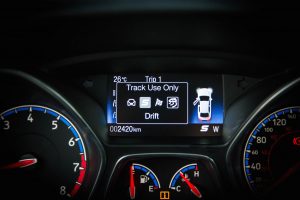
The one thing the RS shares with the factory racers of yore is that it comes only with a manual transmission.
But even then, it’s not like it was.
The clutch is hydraulically assisted and has normal car take-up. It is not either in – or out. And so, it is easy to drive in stop-and-go-traffic; it is not not like doing leg presses at the gym – like it was back in the day.
The turbo 2.3 liter engine isn’t a peaky engine, either. You don’t have to rev it to keep it from falling flat on its face. It never falls flat on its face. The torque available from idle onward is more than most V6s make and in the same ballpark from the mid-range onward as many V8s.
It is very grocery-getter/commuter-car viable. In fact, it drives as easily as the ST – and better than the standard-issue Focus, which has the disadvantage of not much power anywhere. The irony is that the more focused ST and even-more-focused RS are better everyday cars than the standard Focus because they both have the beans to merge swiftly with traffic, pass slow-moving traffic and so on.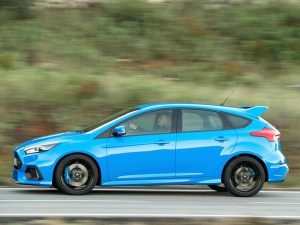
The only areas where the RS is deficient as an everyday car is ride quality – which is as firm as a California surfer’s six pack and made to feel even firmer via the laterally supportive but not-much-give Recaro sport buckets and inch-high sidewall 35-series Michelin Pilot Super Sport track day tires that come with the deal.
Then again, the Soobie WRX STi is just as rough on the cheeks and back.
On the other hand, the Golf R is not – and it’s available with an automatic (DSG dual clutch) transmission. 
Despite the AWD, there is a little herky-jerky torque steer when you really get on it from a standstill. Probably that’s because the default is front-wheel-drive; power is kicked back to the rear wheels as the front wheels begin to lose grip. And that happens pretty immediately when you do floor it and the twin-scroll turbo wins up to 24-ish pounds of boost and the full 350-350 (horsepower and torque) initially overwhelm the front wheels of what is – underneath it all – a car that was originally designed to be an economy car.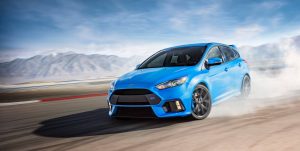
Same issue with the WRX STi.
But, this is part of the fun of these cars. They are over-engined, as intended. Here there is spiritual and visceral commonality with the V8 bruisers of my youth. They had too much engine – and not enough tire (typically, 15×7 wheels, if you can imagine it, fitted to a 4,000 pound car with a 400 hp V8).
Hilarious.
And you can drift the RS – all four wheels – even more fun than fishtailing around the curves in an overpowered, under-rubbered RWD V8 muscle car. Select Drift Mode and let fly. Plus, of course, there is the emergency brake. Pull-up style.
As Eric the Actor used to say: You know what to do.
AT THE CURB
In keeping with trends – the trend away from sedans – the RS is built on the hatchback’d version of the Focus . The reason for this being that sedans are just not very practical – especially compact-sized ones. The Focus sedan has a compact-sized trunk – just 13.2 cubic feet of space – vs. 19.9 cubic feet of cars capacity behind the second seats in the hatchback, whether standard-issue or ST or RS. Fold the seats down and the total space available for cargo opens up to more than twice that.
Interestingly – and in the Ford’s favor – the current Subaru WRX STi comes only as a sedan – and it has a small sedan’s tiny trunk (just 12 cubic feet).
The Golf R is roomier than both – in part because of its taller roofline and boxier profile. It has 22.8 cubic feet of space behind its second row.
Backseat legroom is a little tight in the RS – 33.2 inches vs. 35.4 in the Subaru and 35.6 in the Golf R.
Still, that’s about six inches more legroom than in two-door/allegedly “two-plus-two” muscle coupes like Mustang and Camaro, which have back seats in name only. It’s so bad in Camaro’s case that GM doesn’t eve publish the number (it’s around 27 inches, if the front seats are slid forward . . . a lot).
The R excels at maintaining a lower profile – especially vs. the gaudy WRX STi, with its anodized/contrast-colored mag wheels, gaping hood scoop and Valkyrie mach 3 bomber airfoil bolted to its trunk. It calls attention to itself like Borat running naked through the Vatican in a yellow banana thong.
With the RS you can tell something’s up. But not 350 hp up.
Other than the different grille, the more aggressive wheel/tire package and the subtle airfoil that’s discreetly blended into the roofline rather than towering over the trunk, XB-70-style, the RS looks much like the ST, which looks not too far removed from the ho-hum Focus.
And ho-hum is what you want if you intend to use this thing instead of pose in it.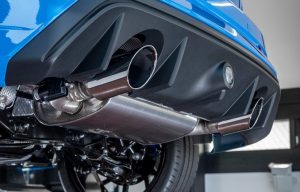
Even the exhaust is pretty quiet – notwithstanding the humungous duals out back. Well, unless you hammer it. In which case, a baffle pops open, releasing the back pressure with a very noticeable, wastegate-esque pop. But this is entirely right foot-controllable. You can slide right by a cop and sound just like a standard-issue Focus.
Ho! ho!
THE REST
The RS comes standard with the latest version of Ford’s Sync3 LCD touchscreen interface and it’s easier to use than the Soobie’s system, which has neat-looking but clunky-to-operate finger slide controls.
The Ford also has a larger (8-inch) screen than either the Soobie or the VW Golf R.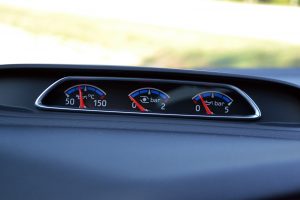
On the downside, if you care about such things, the RS doesn’t have a display for the workings of its AWD system that lets you watch the power transfer in real time, as you drive (both the STi and the Golf R do have that) and the accessory gauges for turbo boost, oil pressure and oil temperature are small and the mounting they’re housed in on top of the center stack looks tacked on.
Ford has also had to add the annoying Auto Stop/Start system to this car.
This is something all car companies are doing, in order to eke out fractional upticks in fleet fuel economy – basically, if they can get a single Focus to use .5 of a gallon less gas via shutting off the engine at red lights and whenever else the car rolls to a stop – times 100,000 or however many Focuses Ford builds in a given year, Ford’s overall Corporate Average Fuel Economy (CAFE) number rises slightly higher and Uncle will impose slightly less harsh gas guzzler taxes.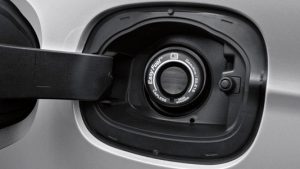
You can turn the Auto Stop/Start iff by using a button on the center console. But it’s annoying regardless because you have to remember to do it every time you go for a drive. Otherwise, the engine turning itself off at the next red light (and with it, the AC) will remind you.
This car – like all new Fords – has a capless fuel fill. You just insert the nozzle and fill ‘er up. If you ever run out of gas and have to fill it using a can, you will need the little white plastic adapter funnel they put in the glovebox. Insert this first, or your attempt to add gas will be a slow and messy process – because the capless system is designed to mesh with gas station pump nozzles and has a little door/catches (for evaporative emissions reasons) that a gas can’s nozzle does not mesh with. Do not lose the little adapter!
As with Auto Start/Stop, thank Uncle.
Also, the car’s gas tank is small – not surprising given its economy car (and high-mileage) origins. Just over 12 gallons – which lasts a while hen you’re averaging 30-something MPG but a lot less long when you’re averaging 20.
An interesting option is a Winter wheel and tire package that swaps out the track day-focused Michelin Pilots on the otherwise standard 19 inch rims for winter tires mounted on 18 inch rims.
So equipped, you can really drift!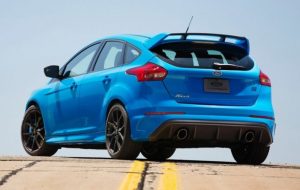
THE BOTTOM LINE
Wepner never actually knocked out Ali.
The RS has the punching power to do just that to the Soobie STi.
If you like what you’ve found here, please consider supporting EPautos.
We depend on you to keep the wheels turning!
Our donate button is here.
If you prefer not to use PayPal, our mailing address is:
EPautos
721 Hummingbird Lane SE
Copper Hill, VA 24079
PS: EPautos stickers are free to those who send in $20 or more to support the site. 


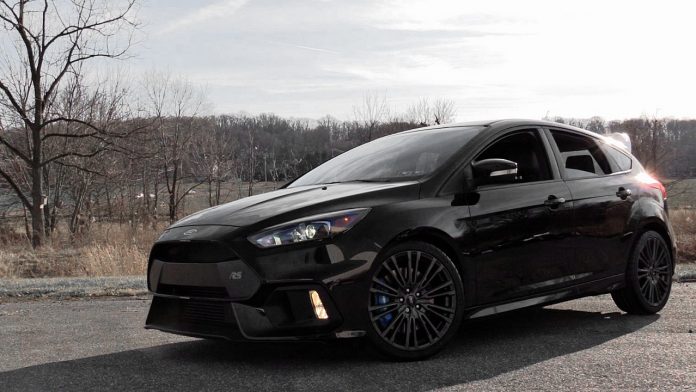

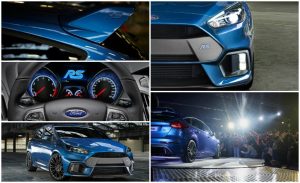
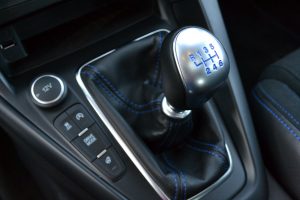
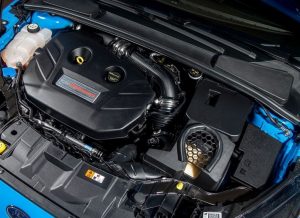

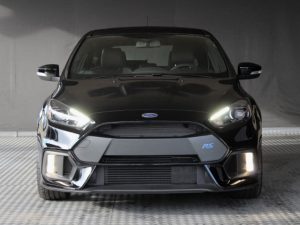






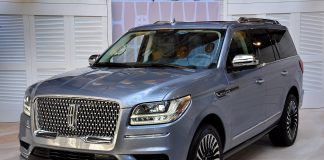
These are awesome cars. I have an Audi TTRS for similar reasons. 5 cyl tuned to 450 hp, AWD, lighter and a MANUAL tranny. light on it’s feet and a sleeper. I’ve smoked several big V8 type cars. As this is the last manual tranny Audi I’ll keep this and my gated manual tranny R8 V10 for life. Having said that I could see the Focus RS in a year or so for my DD.
Hi Robert,
I’m a big fan, too. Except for the Recaros. They are great for track days, but for everyday… not so much. The Golf R is a much more everyday friendly car. But even though it’s quicker, it’s not as fierce feeling.
The RS reminds me a lot of an old muscle car that way.
It’s hairy.
Few new cars are!
There are V8 RWD conversion kits out on the market for the previous generation Focus. Maybe for this generation as well.
I just bought one of these over the weekend. I love this car because it’s so over the top! It backfires when you let off the gas, the traction is great, and I don’t even have the upgraded tires, and it’s got no nannies which try to keep you in lane or beep at your when someone gets too close. I wish it was lighter – there’s a whole lot of useless electronics stereo in the trunk and no spare tire. Hilariously, it’s got a fake engine noise generator to make it sound more sporty – its easily disabled by pulling out a plug in the trunk.
There are lots of active systems in this car, it’s complicated, and it’s got DFI which means it’ll probably foul its valves with residue. When you push it really hard, the rear diff overheats and turns off, and it turns into a front wheel drive car until it turns off. My track car, which has seen ten years of track driving, has none of these active systems and it’ll run all day at 10/10 without anything overheating.
Brie Olsen’s bikini
Cheese porn?
Ford seems to be hitting it out of the park lately with their cars. Too bad they sell so many F-150s that they need to resort to aluminum to get the weight down. But if they get it right on the trucks maybe we’ll see lighter cars (better power to weight ratio) down the road too.
Any idea how the aftermarket is treating this car? Throwing a NOX system on this thing could get that extra .3 seconds. Putting a fuel cell in the back could get a longer time between pit stops.
Subaru is kind of dead in the water as regards the STi… if I had to pick one of the two, it’d be the Ford… no hesitation.
The traction control thankfully can be fully turned off by pressing and holding the switch for 5 seconds for added fun.
Hi Grant,
The emergency brake works well, too!
I’ve had some Fords where the stability control will still work and try to compensate for the e-brake.